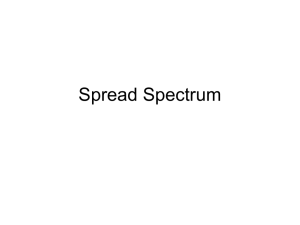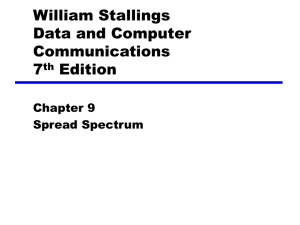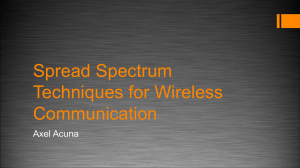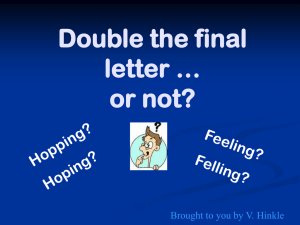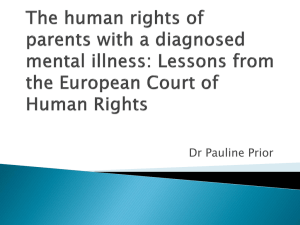Hopping band
advertisement
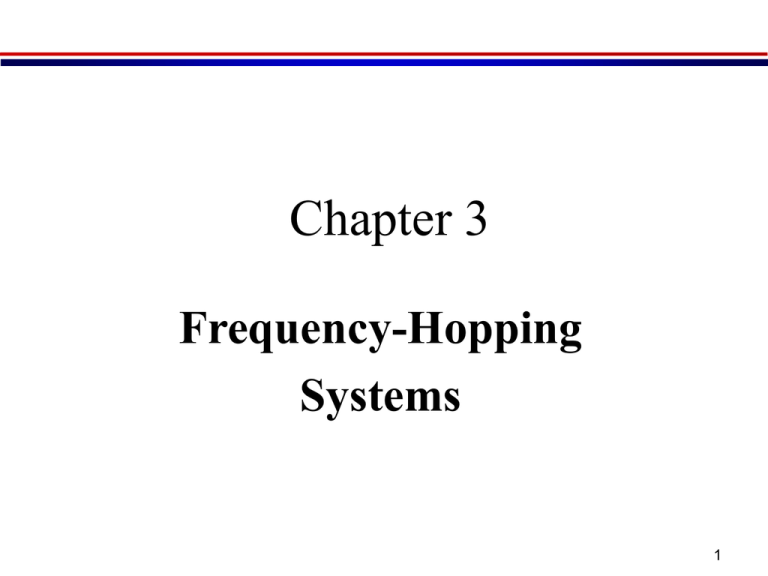
Chapter 3 Frequency-Hopping Systems 1 3.1 Concepts and Characteristics • Frequency hopping – The periodic changing of the carrier frequency of a transmitted signal. • Hopset – The set of M possible carrier frequencies • Frequency hopping pattern – The sequence of carrier frequencies. • Hopping band – Hopping occurs over a frequency band that includes M frequency channels. 2 • hop duration – The time interval between hops • The hopping band has bandwidth W MB 3 4 • If the data modulation is some form of angle modulation ( x) then the received signal for the ith hop is • dehopping – The mixing operation removes the frequency-hopping pattern from the received signal. • Frequency hopping enables signals to hop out of frequency channels with interference or slow frequency-selective fading. – spectral notching • Some spectral regions with steady interference or a susceptibility to fading may be omitted from the hopset. 5 6 • Transmission security – The specific algorithm for generating the control bits is determined by the key and the time-of-day (TOD). • The key is a set of bits that are changed infrequently and must be kept secret. • The TOD is a set of bits that are derived from the stages of the TOD counter and change with every transition of the TOD clock. – The purpose of the TOD is to vary the generator algorithm without constantly changing the key. – The generator algorithm is controlled by a time-varying key. – The code clock, which regulates the changes of state in the code generator and thereby controls the hop rate, operates at a much higher rate than the TOD clock. 7 • Dwell interval – A frequency-hopping pulse with a fixed carrier frequency occurs during a portion of the hop interval. • dwell time – The duration of the dwell interval during which the channel symbols are transmitted. 8 • The hop duration Th is equal to the sum of the dwell time Td and the switching time Tsw. – The switching time is equal to the dead time plus the rise and fall times of a pulse. • dead time is the duration of the interval when no signal is present • The nonzero switching time decreases the transmitted symbol duration Ts . • If Tso is the symbol duration in the absence of frequency hopping, then • The reduction in symbol duration expands the transmitted spectrum and thereby reduces the number of frequency channels within a fixed hopping band. 9 • Fast frequency hopping – If there is more than one hop for each information symbol. • Slow frequency hopping – If one or more information symbols are transmitted in the time interval between frequency hops. • Let M denote the hopset size, B denote the bandwidth of frequency channels, and Fs denote the minimum separation between adjacent carriers in a hopset. • For full protection against stationary narrowband interference and jamming, it is desirable that so that the frequency channels are nearly spectrally disjoint. • A hop then enables the transmitted signal to escape the interference in a frequency channel. 10 • Symbol errors are independent if the fading is independent in each frequency channel and each symbol is transmitted in a different frequency channel. • If each of the interleaved code symbols is transmitted at the same location in each hop dwell interval, then adjacent symbols are separated by Th after the interleaving. • The sufficient condition for nearly independent symbol errors is where Tcoh is the coherence time of the fading channel. Bcoh is the coherence bandwidth of the fading channel. 11 • For a hopping band with bandwidth W, and a hopset with a uniform carrier separation, • If nearly independent symbol errors are to be ensured, the number of frequency channels is constrained by • If B < Bcoh equalization will not be necessary because the channel transfer function is nearly flat over each frequency channel. • If B ≧ Bcoh equalization may be used to prevent intersymbol interference. 12 • In military applications, the ability of frequency-hopping systems to avoid interference is potentially neutralized by a repeater jammer (also known as a follower jammer), which is a device that intercepts a signal, processes it, and then transmits jamming at the same center frequency. • To be effective against a frequency-hopping system, the jamming energy must reach the victim receiver before it hops to a new set of frequency channels. • Thus, the hop rate is the critical factor in protecting a system against a repeater jammer. 13 3.2 Modulations • FH/MFSK system – Uses MFSK as its data modulation. – One of q frequencies is selected as the carrier or center frequency for each transmitted symbol, and the set of q possible frequencies changes with each hop. – An FH/MFSK signal has the form • is the average signal power during a dwell interval. • is a unit-amplitude rectangular pulse of duration Ts. • Nh is the number of symbols per dwell interval. 14 15 • The effective number of frequency channels is – M : the hopset size. – q : frequencies or tones in an MFSK set • For noncoherent orthogonal signals, the MFSK tones must be separated enough that a received signal produces negligible responses in the incorrect subchannels. • The frequency separation must be – k is a nonzero integer. – Ts denotes the symbol duration. – To maximize the hopset size when the MFSK subchannels are contiguous, k=1 is selected. 16 • The bandwidth of a frequency channel for slow frequency hopping with many symbols per dwell interval is – Tb is the duration of a bit. • The hopset size is 17 Soft-Decision Decoding • We consider an FH/MFSK system that uses a repetition code and the receiver of Figure 3.5(b). • Each information symbol, which is transmitted as L code symbols, may be regarded as a codeword or as an uncoded symbol that uses diversity combining. • The interference is modeled as wideband Gaussian noise uniformly distributed over part of the hopping band. • Slow frequency hopping with a fixed hop rate and ideal interleaving. • The optimal metric for the Rayleigh-fading channel and a good metric for the additive-white-Gaussian-noise (AWGN) channel without fading is the Rayleigh metric which is 18 19 • Linear square-law combining – Rli is the sample value of the envelope-detector output that is associated with code symbol i of candidate informationsymbol. – L is the number of repetitions or code symbols. • This metric has the advantage that no side information, which is specific information about the reliability of symbols, is required for its implementation. • A performance analysis of a frequency-hopping system with binary FSK and soft-decision decoding with the Rayleigh metric indicates that the system performs poorly against worst case partial-band jamming [6] primarily because a single jammed frequency can corrupt the metrics. 20 • Nonlinear square-law combining – Noi is the two-sided power spectral density of the interference and noise over all the MFSK subchannels during code symbol i. • Variable-gain metric: 21 • Suppose that the interference is partial-band jamming. – N1/2: the two-sided power-spectral density – μ: the fraction of the hopping band with interference . – It0 : the spectral density that would exist if the interference power were uniformly spread over the entire hopping band. • Upper bound on the information-bit error probability: where 22 • Suppose that the interference is worst-case partial-band jamming. • An upper bound on Pb is obtained by maximizing the right-hand side of (3-27) with respect to μ. • Calculus yields the maximizing value of • Substituting (3-28) into (3-27), we obtain 23 • let L0 denote the minimizing value of L. 24 • The upper bound on Pb for worst-case partial-band jamming when L= L0 is given by – This upper bound indicates that Pb decreases exponentially as increases if the appropriate number of repetitions is chosen. • Thus, the nonlinear diversity combining with the variable-gain metric sharply limits the performance degradation caused by worst-case partial-band jamming relative to full-band jamming. 25 • Substituting (3-30) into (3-28), we obtain • This result shows that the appropriate choice of L implies that worst-case jamming must cover three-fourths or more of the hopping band. • The task may not be a practical possibility for a jammer. 26 Narrowband Jamming Signals • Although (3-31) indicates that it is advantageous to use nonbinary signaling (m > 1) when . • This advantage is completely undermined when distributed, narrowband jamming signals are a threat. • A sophisticated jammer with knowledge of the spectral locations of the MFSK sets can cause increased system degradation by placing one jamming tone or narrowband jamming signal in every MFSK set. 27 • To assess the impact of this sophisticated multitone jamming on hard decision decoding in the receiver of Figure 3.5(b), – It is assumed that thermal noise is absent and that each jamming tone coincides with one MFSK tone in a frequency channel encompassing q MFSK tones. • Whether a jamming tone coincides with the transmitted MFSK tone or an incorrect one, there will be no symbol error if the desired-signal power S exceeds the jamming power. • If It is the total available jamming power, then the jammer can maximize symbol errors by placing tones with power levels slightly above S whenever possible in approximately J frequency channels such that 28 • If a transmitted tone enters a jammed frequency channel and then with probability , the jamming tone will not coincide with the transmitted tone and will cause a symbol error after hard-decision decoding. • Since J/M is the probability that a frequency channel is jammed, the symbol error probability is • Substitution of (3-8), (3-9), and (3-34) into (3-35) yields 29 – – denotes the energy per bit. denotes the spectral density of the interference power that would exist if it were uniformly spread over the hopping band. • This equation exhibits an inverse linear dependence of Ps on • It is observed that Ps increases with q which is the opposite of what is observed over the AWGN channel. • Thus, binary FSK is advantageous against this sophisticated multitone jamming. 30 3.3 Hybrid Systems • Frequency-hopping systems reject interference by avoiding it, whereas direct-sequence systems reject interference by spreading it. • Channel codes are more essential for frequency-hopping systems than for direct-sequence systems. – Because partial-band interference is a more pervasive threat than high-power pulsed interference. • When frequency-hopping and direct-sequence systems are constrained to use the same fixed bandwidth, then directsequence systems have an inherent advantage. – They can use coherent PSK rather than a noncoherent modulation. – Coherent PSK has an approximately 4 dB advantage relative to noncoherent MSK over the AWGN channel and an even larger advantage over fading channels. 31 • A major advantage of frequency-hopping systems – It is possible to hop into noncontiguous frequency channels over a much wider band than can be occupied by a directsequence signal. – This advantage more than compensates for the relatively inefficient noncoherent demodulation that is usually required for frequency-hopping systems. – Excluding frequency channels with steady or frequent interference. – The reduced susceptibility to the near-far problem and the relatively rapid acquisition. 32 • A hybrid frequency-hopping direct-sequence system – A frequency-hopping system that uses direct-sequence spreading during each dwell interval – Or, equivalently, a direct-sequence system in which the carrier frequency changes periodically. 33 34 • • • Hops occur periodically after a fixed number of sequence chips. Because of the phase changes due to the frequency hopping, noncoherent modulation, such as DPSK, is usually required unless the hop rate is very low. Serial-search acquisition occurs in two stages. 1. To provide alignment of the hopping patterns. 2. The phase of the pseudonoise sequence finishes acquisition rapidly. – Because the timing uncertainty has been reduced by the first stage to less than a hop duration. 35 • A hybrid system curtails partial-band interference in two ways. – The hopping allows the avoidance of the interference spectrum part of the time. – When the system hops into the interference, the interference is spread and filtered as in a direct-sequence system. • Large bandwidth limits the number of available frequency channels, which increases the susceptibility to narrowband interference and the near-far problem. • Hybrid systems are seldom used except perhaps in specialized military applications because the additional direct-sequence spreading weakens the major strengths of frequency hopping. 36 3.4 Applications • Anti-jamming is an important application for spread spectrum modulations. • In addition to anti-jamming, we will briefly introduce several other spread spectrum applications in this section. • In describing these applications, we focus on DS-SS systems. • One should note that other spread spectrum techniques also have similar applications since the main idea behind these applications is the spreading of the spectrum. 37 3.4.1 Anti-jamming • We know that we can combat a wide-band Gaussian jammer by spreading the spectrum of the data signal. • Here we consider another kind of jammers—the continuous wave (CW) jammers. • Suppose the spread spectrum signal is given by • It is jammed by a sinusoidal signal with frequency power PJ . • The received signal is given by and where n(t) represents the AWGN. 38 • We can easily see that the power spectrum of the received signal r(t) is given by • We consider the matched filter receiver in the equivalent correlator form in Figure 3.11. Figure 3.11: Matched filter receiver (correlator form) for DS-SS 39 • At the output of the despreader, the signal z(t) can be expressed as • It can be shown that the power spectrum of the despread signal z(t) is • Now the anti-jamming property of the spread spectrum modulation can be explained by comparing the spectra of the signals before and after despreading in Figure 3.12. 40 Figure 3.12: Spectra of signals before and after despreading 41 • Before despreading, the jammer power is concentrated at frequency and the signal power is spread across a wide frequency band ([-2π/Tc, 2π/Tc]). • The despreader spreads the jammer power into a wide frequency band ([-2π/Tc, 2π/Tc]) while concentrates the signal power into a much narrower band ([-2π/T, 2π/T]). • The integrator acts like a low-pass filter to collect power of the despread signal over the frequency band ([-2π/T, 2π/T]). 42 • As a result, almost all of the signal power is collected, but only 1/Nth of the jammer power is collected. • The effective power of the jammer is reduced by a factor of N. • This is the reason why N is called the spreading gain. 43 3.4.2 Low probability of detection • Another military-oriented application for spread spectrum is low probability of detection (LPD), which means that it is hard for an unintentional receiver to detect the presence of the signal. • The idea behind this can be readily seen from Figure 3.12. • When the processing gain is large enough, the spread spectrum signal hides below the white noise level. • Without knowledge of the signature sequences, an unintentional receiver cannot despread the received signal. 44 • Therefore, it is hard for the unintentional receiver to detect the presence of the spread spectrum. • We are not going to treat the subject of LPD any further than the intuition just given. • A more detailed treatment can be found in [1, Ch. 10]. 45 2.4.3 Multipath combining • Another advantage of spreading the spectrum is frequency diversity, which is a desirable property when the channel is fading. • Fading is caused by destructive interference between time-delayed replica of the transmitted signal arise from different transmission paths (multipaths). • The wider the transmitted spectrum, the finer are we able to resolve multipaths at the receiver. 46 • Loosely speaking, we can resolve multipaths with pathdelay differences larger than 1/W seconds when the transmission bandwidth is W Hz. • Therefore, spreading the spectrum helps to resolve multipaths and, hence, combats fading. • The best way to explain multipath fading is to go through the following simple example. • Suppose the transmitter sends a bit with the value “+1” in the BPSK format, i.e., the transmitted signal envelope is pT (t), where T is the symbol duration. 47 • Assume that there are two transmission paths leading from the transmitter to the receiver. • The first path is the direct line-of-sight path which arrives at a delay of 0 seconds and has a unity gain. • The second path is a reflected path which arrives at a delay of 2Tc seconds and has a gain of -0.8, where Tc = T/10 is the chip duration of the DS-SS system we are going to introduce in a moment. 48 • The overall received signal can be written as where n(t) is AWGN. • To demodulate the received signal, we employ the matched filter receiver, which is matched to the direct line-of-sight signal, i.e., h(t) = pT (T - t). • The output of the matched filter is plotted in Figure 3.13. • We can see from the figure that the contribution from the second path partially cancels that from the first path. 49 • Figure 3.13: Matched filter output for the two-path channel without spreading 50 • We sample the matched filter output at time t = T. • The signal contribution in the sample is 0.36T and the noise contribution is a zero-mean Gaussian random variable with variance N0T. • Compared to the case where only the direct line-of-sight path is present, the signal energy is reduced by 87%, while the noise energy is the same. • Therefore, the bit error probability is greatly increased. 51 • Now, let us spread the spectrum by the spreading signal where • DS-SS system is • Again, we consider using the matched filter receiver, which is matched to a(t). • The output of the matched filter is shown in Figure 3.14. • We can clearly see from the figure that the contributions from the two paths are separated since the resolution of the spread system is ten times finer than that of the unspread system. 52 • Figure 3.14: Matched filter output for the two-path channel with spreading 53 • If we sample at t = T, we get a signal contribution of T, which is the same as what we would get if there was only a single path. • Hence, unlike what we saw in the unspread system, multipath fading does not have a detrimental effect on the error probability. • In fact, we will show in Chapter 4 that we can do better by taking one more sample at t = T + 2Tc to collect the energy of the second path. • If we know the channel gain of the second path, we can combine the paths coherently. • Otherwise we can perform equal-gain noncoherent combining. This ability of the spread spectrum modulation to collect energies from different paths is called multipath combining. 54 3.5 References [1] R. L. Peterson, R. E. Ziemer, and D. E. Borth, Introduction to Spread Spectrum Communications, Prentice Hall, Inc., 1995. [2] M. B. Pursley, “Performance evaluation for phase-coded spread-spectrum multiple-access communication — Part I: System analysis,” IEEE Trans. Commun., vol. 25, no. 8, pp. 795–799, Aug. 1977. [3] R. A. Scholtz, “Multiple access with time-hopping impulse modulation,” Proc. MILCOM ’93, pp. 11-14, Boston, MA, Oct. 1993. [4] N. Yee, J. M. G. Linnartz, and G. Fettweis, “Multi-carrier CDMA in indoor wireless radio networks,” IEICE Trans. Commun., vol. E77-B, no. 7, pp. 900– 904, Jul. 1994. [5] S. Kondo and L. B. Milstein, “Performance of multicarrier DS CDMA systems,” IEEE Trans. Commun., vol. 44, no. 2, pp. 238–246, Feb. 1996. [6] R. L. Pickholtz, L. B. Milstein, and D. L. Schilling, “Spread spectrum for mobile communications,” IEEE Trans. Veh. Technol., vol. 40, no. 2, pp. 313– 321, May 1991. [7] D. Torrieri, “Principles of spread spectrum communications theory,” Springer 2005. 55
